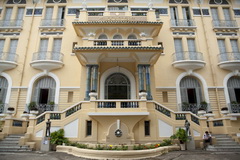



Located at number 161/85/20, Lac Long Quan Street, District 11, Giac Vien is one of the oldest temples in Ho Chi Minh City. At first, it only used to be a warehouse while another pagoda (named Giac Lam) was being rebuilt. After the renovation of the latter was completed, Giac Vien Pagoda was extended as a thatched-roof hut used for worshipping Bodhisattva and was named Kwan-Yin. Finally, it became a pagoda in 1850, thanks to the monk Hai Tinh Giac Vien. People said that Emperor Gia Long of Nguyen Dynasty used to worship at Giac Vien – known as the centre of Buddhism of the 6 southern provinces in 19th century. Originally constructed in 1789, this pagoda underwent major restorations in 1899 and 1910. Today, it still preserves many Buddhist printing inscriptions of considerable value.

Auparavant, ce bâtiment était le Palais Norodom, construit en 1873. En 1954, le président du régime fantoche Ngô Dinh Diêm l’a choisi pour y installer son palais présidentiel. Fin 1962, il a été reconstruit et nommé Palais...

L'Opéra de Saïgon (en vietnamien Nhà hát lớn Thành phố Hồ Chí Minh) est un bâtiment du 1er arrondissement d'Hô-Chi-Minh-Ville. Inspiré de l'architecture de l'Opéra Garnier de Paris, il a été...

Cholon (« grand marché » en vietnamien) est situé au sud-ouest du centre ville de Hô Chi Minh-Ville, à cheval sur les districts (quan) 5 et 6, et correspond au quartier chinois de la ville. Avec ses enseignes en idéogrammes chinois et des masses...

The resplendent Governor's Palace, completed in 1875, symbolized the regime's political power in Asia. And five years later, the Duc Ba (Our Lady's) Cathedral was inaugurated, and became the spiritual and cultural crucible of the French presence in the OrientCet ouvrage a...

Située dans l’arrondissement de Thu Duc sur une superficie de 20 ha, Suôi Tiên est l'une des zones de loisirs les plus populaires pour les habitants de Hô Chi Minh-Ville. Cet endroit a été construit en s'inspirant des animaux sacrés des...

Giac Lam is one of the oldest pagodas in Ho Chi Minh City. Originally, it was built by Ly Thuy Long – a native Minh Huong, in 1744, as a gathering place during Lunar New Year. The new-built temple was like a scenic lookout overlooking Gia Dinh Market while the area was still undeveloped and...

Situated at 339 Nam Ky Khoi Nghia Street, District 3 (just near Cong Ly Bridge), this biggest Mahāyāna Buddhist pagoda in Ho Chi Minh City, is rather a young pagoda. In 1964, when monks Thich Tam Giac and Thich Thanh Kiem from the North came there to spread Buddhism, Vinh Nghiem Pagoda...

Location and history Dai Nam Park is considered as Vietnam’s top man-made tourism spot, which boasts a mix of modern and traditional architectures. An entertainment complex in Binh Duong, on National Highway No. 13, the park was officially brought into use in late 2008. It’s about...

La poste centrale (Buu Dien) constitue un témoignage important de l'architecture française au Vietnam, ce qui explique sa position de monument incontournable d'Ho Chi Minh-Ville.Fondée entre 1886 et 1891, ce bel immeuble rappelle les constructions parisiennes. Ainsi,...

Le musée des Beaux-Arts (Bao Tang My Thuat) se donne à voir dans une belle demeure particulière au n° 97 de la rue Pho Duc Chinh, au sud du centre ville. Il s'agit en effet d'un édifice Art Déco, orienté selon les règles du Feng Shui,...

Soyez le premier à connaître nos offres de voyage exclusives et les nouveaux circuits !.